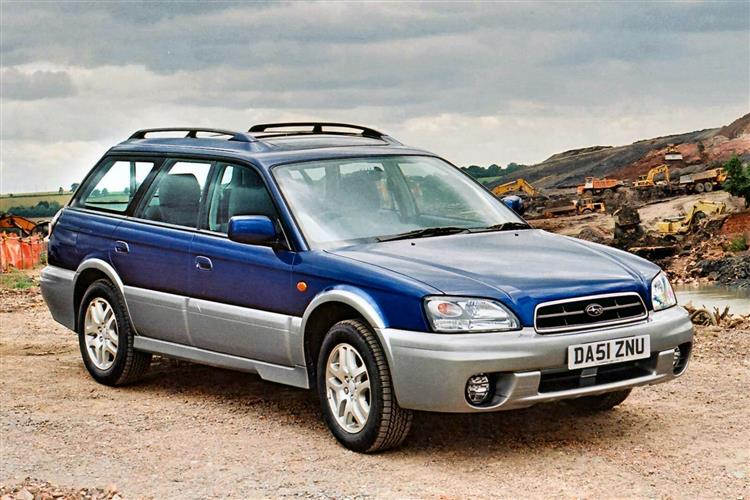THE GREAT OUTDOORS (some text hidden) --NONE--
BY ANDY ENRIGHT
Introductionword count: 112
Long before Audi devised the Allroad or Volvo ever came up with the V70 Cross Country, Subaru were marketing an all-wheel drive estate with extra ground clearance in the uncompromising shape of the Legacy Outback. Realising that their traditional market - aside from turbocharged Impreza customers - was still much enamoured of rugged estate cars that could do an honest day's work, the Outback was a logical extension of the Legacy brand. There's no shortage of used examples in the system, some in better shape than others. The Outback has a reputation as one of the most reliable cars you can buy but it pays to look at a few before buying.
Modelsword count: 28
Models Covered: 1996 - 98 Series 1 Legacy Outback 2.5 1998 - 2003 Series 2 Legacy Outback 2.5, H6-3.0 2003 - to date Series 3 Outback 2.5, 3.0R
Historyword count: 307
The Outback was a car that Subaru had never really earmarked for the British market, instead concentrating initially on Japan and the US where these sorts of vehicle s go down very well. The precedent in the UK for rugged all-wheel drive estates was patchy at best and the importers dipped a tentative toe into the water when they decided to bring in limited numbers of 148bhp Outback 2.5-litre models in late 1996. Despite the low key introduction, demand seemed strong and throughout 1997 this model sold steadily, establishing a reputation for itself as a solid, no-nonsense performer that appeared astonishingly reliable. In December 1998 the Legacy range received a thorough facelift and the Outback series received more changes. As well as the 2.5-litre engine being boosted to 154bhp, a rather thirsty 209bhp 3.0-litre flat-six engined version, the H6-3.0, was introduced. The suspension was revised and the front end got bigger headlamps. The interior was thoroughly revised with the fascia angled towards the driver. In August 1999 Subaru added Vehicle Dynamic Control to the Legacy Outback range but it wasn't until the 2002 model year car that the shape got tinkered with again, the Outback featuring double deck headlamps with inlaid circular indicators and ornate multi-reflectors all housed in a large pod. The grille was also revised, being made deeper and wider, giving the slightly bland Outback front end a good deal more presence. This was backed up by a more aggressive front and rear bumper and sill treatment. The 2004 model year Outback - which dropped the Legacy part of its name - was unveiled in summer 2003 and featured sleeker styling and superior materials used in the cabin. Further tweaks were made in the summer of 2005 with subtly revised styling and various tweaks to improved handling. Interior materials were also upgraded at this juncture.
What You Getword count: 298
Ever-so slightly unusual looks, eccentric touches like Subaru's 'hill-holder' device (makes hill starts easier for those who never got the hang of a normal handbrake), superb quality and great reliability. Most will buy these cars for their all-weather transmission. The fact that a Subaru doesn't look like a four-wheel-drive is exactly why many people buy them. The Legacy has always been a favourite of the dale-dwelling doctor-on-call, so if you can find a one-owner country car, all the better. You might only need the all-wheel drive a few days a year, but, like having air conditioning in a heat wave, you'll never be without it again. The Series 2 models built between 1998 and 2003 are most commonplace on our roads and they're tough but very well equipped. The 2.5-litre model features a clever list of standard equipment and true to form they include everything but the kitchen sink. No, scratch that: you do get a kitchen sink - in the form of a 'washing-up bowl' in the boot well, said to be ideal for items like muddy walking boots. More common standard features include a top quality stereo CD system, air conditioning, twin front and side airbags, ABS, and alloy wheels. Inside, there are heated front seats with the dashboard and armrests colour-co-ordinated in beige and brown. It doesn't quite disguise the plastic however - and the mock-wood fascia fittings seem a touch contrived. The 3.0-litre version gets heated front seats with the dashboard and armrests colour-co-ordinated in beige and brown. Although the interior isn't the most stylish, the Mercedes-like auto-gear selector gate is evidence that they've been learning from the Europeans. Nice touches include illuminated vanity mirrors, a de-icing system for the windscreen wipers and heated door mirrors, plus of course the obligatory retractable cup holder.
To see the full road test text contact us on 0330 0020 227
Pictures (high res disabled)

Scoring (subset of scores)
Category: Crossover or SUV 4x4s
| Performance | |
| Handling | |
| Comfort | |
| Space | |
| Styling, Build, Value, Equipment, Depreciation, Handling, Insurance and Total scores are available with our full data feed. | |



